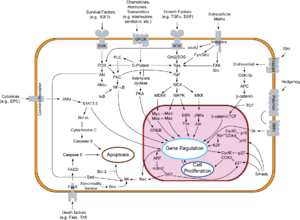Mitochondria and Cardiovascular Disease
Curator: Larry H Bernstein, MD, FACP
This article is the FIRST in a four-article Series covering the topic of the Roles of the Mitochondria in Cardiovascular Diseases. They include the following;
- Mitochondria and Cardiovascular Disease: A Tribute to Richard Bing, Larry H Bernstein, MD, FACP
http://pharmaceuticalintelligence.com/2013/04/14/chapter-5-mitochondria-and-cardiovascular-disease/
- Mitochondrial Metabolism and Cardiac Function, Larry H Bernstein, MD, FACP
http://pharmaceuticalintelligence.com/2013/04/14/mitochondrial-metabolism-and-cardiac-function/
- Mitochondrial Dysfunction and Cardiac Disorders, Larry H Bernstein, MD, FACP
http://pharmaceuticalintelligence.com/2013/04/14/mitochondrial-dysfunction-and-cardiac-disorders/
- Reversal of Cardiac mitochondrial dysfunction, Larry H Bernstein, MD, FACP
http://pharmaceuticalintelligence.com/2013/04/14/reversal-of-cardiac-mitochondrial-dysfunction/
- Bing also wrote a number of non-medical books including a novel and several short stories.
- mitochondrial metabolism,
- energetics
- regulatory function, and dysfunction,
- the process leading to apoptosis
- a larger effect on disease.
- organ specific differences in the rates of organelle mutation errors and in the rates of repair.
- iron-binding in the function of the cell,
- Ca2+ binding in the creation of the mechanical work.
- the balance between protein synthesis and protein degradation.
- rates of protein synthesis and degradation are equal.
- complete destruction of its protein substrates, but
- in limited proteolysis and posttranslational processing
- it generates biologically active peptides or fragments.
- ubiquitin C-terminal hydrolases (isopeptidases).
- at the level of protein degradation effectively controls protein levels.
- protein phosphorylation plays an important role.
- a heterotrimeric Gi3-protein,
- phosphatidylinositol 3-kinase
- p70S6 kinase.
- central to consider in cardiac dysfunction –
Related articles
- Clues to heart disease in unexpected places, Temple researchers discover (eurekalert.org)
- Statins prevent cardiovascular disease, but safer alternatives available (foodconsumer.org)
- selenium and Q10 reduces mortality from cardiovascular disease (healthlift.wordpress.com)
References
Mitochondrial dynamics and cardiovascular diseases Ritu Saxena
http://pharmaceuticalintelligence.com/2012/11/14/mitochondrial-dynamics-and-cardiovascular-diseases/
Mitochondrial Damage and Repair under Oxidative Stress larryhbern
http://pharmaceuticalintelligence.com/2012/10/28/mitochondrial-damage-and-repair-under-oxidative-stress/
Mitochondria: Origin from oxygen free environment, role in aerobic glycolysis, metabolic adaptation larryhbern
http://pharmaceuticalintelligence.com/2012/09/26/mitochondria-origin-from-oxygen-free-environment-role-in-aerobic-glycolysis-metabolic-adaptation/
Ca2+ signaling: transcriptional control larryhbern
http://pharmaceuticalintelligence.com/2013/03/06/ca2-signaling-transcriptional-control/
MIT Scientists on Proteomics: All the Proteins in the Mitochondrial Matrix identified Aviva Lev-Ari
http://pharmaceuticalintelligence.com/2013/02/03/mit-scientists-on-proteomics-all-the-proteins-in-the-mitochondrial-matrix-identified/
Nitric Oxide has a ubiquitous role in the regulation of glycolysis -with a concomitant influence on mitochondrial function larryhbern
http://pharmaceuticalintelligence.com/2012/09/16/nitric-oxide-has-a-ubiquitous-role-in-the-regulation-of-glycolysis-with-a-concomitant-influence-on-mitochondrial-function/
Ubiquinin-Proteosome pathway, autophagy, the mitochondrion, proteolysis and cell apoptosis larryhbern
http://pharmaceuticalintelligence.com/2013/02/14/ubiquinin-proteosome-pathway-autophagy-the-mitochondrion-proteolysis-and-cell-apoptosis-reconsidered/
Low Bioavailability of Nitric Oxide due to Misbalance in Cell Free Hemoglobin in Sickle Cell Disease – A Computational Model Anamika Sarkar
http://pharmaceuticalintelligence.com/2012/11/09/low-bioavailability-of-nitric-oxide-due-to-misbalance-in-cell-free-hemoglobin-in-sickle-cell-disease-a-computational-model/
The rationale and use of inhaled NO in Pulmonary Artery Hypertension and Right Sided Heart Failure larryhbern
http://pharmaceuticalintelligence.com/2012/08/20/the-rationale-and-use-of-inhaled-no-in-pulmonary-artery-hypertension-and-right-sided-heart-failure/
Mitochondria and Cardiovascular Disease: A Tribute to Richard Bing, Larry H Bernstein, MD, FACP
http://pharmaceuticalintelligence.com/2013/04/14/chapter-5-mitochondria-and-cardiovascular-disease/
Mitochondrial Metabolism and Cardiac Function, Larry H Bernstein, MD, FACP
http://pharmaceuticalintelligence.com/2013/04/14/mitochondrial-metabolism-and-cardiac-function/
Mitochondrial Dysfunction and Cardiac Disorders, Larry H Bernstein, MD, FACP
http://pharmaceuticalintelligence.com/2013/04/14/mitochondrial-dysfunction-and-cardiac-disorders/
Reversal of Cardiac mitochondrial dysfunction, Larry H Bernstein, MD, FACP
http://pharmaceuticalintelligence.com/2013/04/14/reversal-of-cardiac-mitochondrial-dysfunction/
Related articles
- Sulfur-Deficiciency and Hyperhomocysteinemia (pharmaceuticalintelligence.com)
- Mitochondrial metabolism and cardiac function (pharmaceuticalintelligence.com)
- Macrophage Migration Inhibitory Factor Inhibition Is Deleterious for High-Fat Diet-Induced Cardiac Dysfunction (plosone.org)
- L-carnitine significantly improves patient outcomes following heart attack (eurekalert.org)
- Mitochondrial Disorders Overview (geneticamedicala.wordpress.com)
- An Appraisal of Human Mitochondrial DNA Instability: New Insights into the Role of Non-Canonical DNA Structures and Sequence Motifs (plosone.org)
- Cardiotoxicity and Cardiomyopathy Related to Drugs Adverse Effects (pharmaceuticalintelligence.com)
- Lp(a) Gene Variant Association (pharmaceuticalintelligence.com)
- Predicting Drug Toxicity for Acute Cardiac Events (pharmaceuticalintelligence.com)
- Amyloidosis with Cardiomyopathy (pharmaceuticalintelligence.com)
Related Pharmaceutical Intelligence articles to follow

Occurrence of the term signal transduction in papers since 1977. These figures were extracted through an analysis of the papers contained within the MEDLINE database. (Photo credit: Wikipedia)

